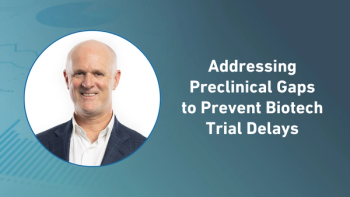
- Applied Clinical Trials-08-01-2006
- Volume 0
- Issue 0
Drug Development on Rails
A project plan based on a fully integrated template can position senior management's expectations to minimize surprises.
The drug development process would rarely be described as being on rails, unless roller coasters were included in the metaphor. However, with integrated project team planning, good project management, and the right tools it is possible to guide the process within narrow boundaries or, remaining true to the metaphor, put it on rails. Key benefits of a well-guided project are efficiency and rapid progress.
Project team and plan
Managing drug development is a complex undertaking. The activities of an individual functional domain or department are often so complex that it is difficult to marry one department's intricate schedule with those of a different functional domain. For example, the chemists and product formulators not only isolate the active substance and create a usable dosage form, but they also provide technical reports for the chemistry, manufacturing and controls (CMC) section of an investigational new drug (IND) submission and manufacture the investigational product (IP) in time to have it available for clinical trials.
On the other hand, toxicologists should not start long-term and expensive carcinogenicity trials until there are positive clinical results. Then again, they should not wait too long or these studies will be on the critical path and hold up the new drug application (NDA)/common technical document (CTD) filing for FDA approval. Figure 1 shows a general overview of how the domains of discovery, CMC, nonclinical, clinical, and regulatory integrate their drug development activities.
Figure 1. The 12-year roadmap to drug regulatory approval.
Project manager
When considering the unique knowledge in each of the five major domains of drug development, one quickly realizes that it takes a magician to coordinate the independent functional activities into a coherent and usable timeline. Yet, that is what good project managers are supposed to do: magic.
Drug development is generally a slow process. Entire careers may be spent on just a few drug development programs. Resident departmental experts rarely have the decades of experience necessary to intrinsically know how their work product dovetails with the requirements of other functional areas. Good project managers are schedule coaches, and they understand how departmental plans integrate into the overall project plan. Departmental leads or representatives who participate in the project team negotiate, but they eventually accept the coach's prioritization and overall integration of each departmental plan into one project plan.
The project plan
A competent coach starts with a plan. A complete, detailed, and integrated project plan is the best place to begin when focusing the valuable energies of functional departments. The plan should be started early. A project plan should be visible to the entire company as soon as discovery has a viable compound/lead or when a licensing agreement is being considered for an external compound.
This article describes a fully integrated template of a project plan used to accelerate NDA-related activities, milestones, and deliverables for a New Chemical Entity (NCE) during an estimated 12-year development cycle. The project template utilizes a regulatory backbone based on the IND and CTD tables of content.
The NCE project template covers the broadest possible array of development milestones. It was built in 13 modular sections, utilizing the five functional domains of Discovery, CMC, Nonclinical, Clinical, and Regulatory. The complete plan contains approximately 8400 tasks. The modularity enables rapid customization for varying projects. The 13 plan modules are: pharmacology discovery and efficacy proof of concept; project initiation; CMC development; nonclinical development; IND preparation; clinical development; CTD preparation; 120-day safety update; final labeling safety update; FDA approval and launch preparation; IND annual reports; CTD periodic updates; and product development and strategy.
The NCE model assumes the compound to be a chemically synthesized IP. From a project planning perspective, biologicals, new indications (sNDA), and generics (ANDA) have differences that would justify a modified template, particularly in the Nonclinical module and commonly in the CMC and Clinical modules. Templates of those variants have also been developed; however, for simplicity, only an NCE example is illustrated. The putative disease for this template is one that can be studied for efficacy in a 60-day "on-study" window in Phase II and III studies. The estimated times used in the NCE project template are customized in case different assumptions need to be made by the project team, or if actual protocols become available with final estimates.
Utilizing the Microsoft (MS) Project® software application, the template takes full advantage of the software's native functionality to properly organize, track, and present a complicated list of operational tasks and timelines. The project timeline self-adjusts based on the project's actual progress.
Project plan rationale
The project plan may be used in many different roles. It serves as a planning tool. It can be a benchmark of company or team performance. It can provide a template that acts as an expert system for how things should be done. It creates a forum for project team member interaction and communication. It may even provide a means for controlling development costs.
Better performance tool
There are always those in an R&D organization who resist being held to a plan. "My work is too dependent on factors outside my control" is a common perspective. Behavioral studies show that productivity dramatically improves if there is some expectation of a deadline.1 Even with the creativity required within a function such as discovery, the department can benefit from having a rough guideline of how long it is allowed to experiment with a molecule before the company expects to have a lead compound to transition into nonclinical and CMC development. It is difficult to operate efficiently in an environment where there are no expectations.
Strategic template and expert system
Executives make better decisions when presented with realistic expectations. A project manager who begins a plan based on a complete and fully integrated template can help position senior management's expectations to minimize surprises.
A 12-year development timeline is far too unwieldy for even the best manager to remember in detail. While creating a customized project plan de novo might be one option, it is more reasonable to use the knowledge embedded in a project plan template. For any IP, the project manager uses whatever information is available from the functional domains, blends it into the project plan template, and modifies it as required. This method provides a far better visualization of what might be required during the multiyear development process for an NCE.
By using a template, senior management has an immediate overview of the entire program, its timeline, resourcing, and costs. Without the aid of a template that provides estimates for timing and resources for the complete project plan, there is great risk of having an R&D program evolve from a limited and inexpensive venture into an open-ended and resource-consuming enterprise. Figure 2 illustrates a collapsed high-level overview of the NCE 12-year development template.
Figure 2. A collapsed, high-level overview of the NCE 12-year development template.
Interaction and communication
Getting an NCE to market requires more than the simple execution of operational work steps by the project team. It takes intelligent interaction, creativity, and interdisciplinary communication over the course of the development cycle.
Figure 3. All disciplines involved in pre-launch preparations, advocacy development, publication strategy, and life cycle planning.
The NCE template includes tasks that prompt marketing assessment and planning, financial evaluations, and management decisions. For example, the template identifies the timing and prompts the team to evaluate technical criteria for graduation of a lead compound from Discovery to CMC and Nonclinical development. It initiates team discussion on how to integrate clinical protocol endpoints with marketing labeling targets. It suggests appropriate timing for clarifying and implementing the strategy for technical and marketing publications, product advocacy development, prelaunch logistics for sales force and training, continuous evaluation of ROI from detailed cost planning and sales projections, and product life-cycle planning. Figures 3 and 4 show examples of how the project plan template prompts the project team to consider these types of cross-functional interactions at appropriate times in the development cycle.
Figure 4. All disciplines in project initiation and financial and marketing review.
Controlling costs
Risk of study failure and study costs are often inversely related to the linear progress down the development process. When risk of failure is high (e.g., in early preclinical stages), the experiments are cheaper to perform. This pattern remains true during clinical, where only a few healthy volunteers are tested in Phase I, while more subjects are enrolled in Phase II and even more in Phase III.
If a compound fails to meet expectations, the project should be terminated, and the earlier a candidate is eliminated from development, the fewer penalties the company pays in investment and opportunity costs. A proficient project team creates stringent technical and clinical criteria designed to eliminate a potentially unsafe or ineffective compound as early as possible in the development cycle.
Aside from prompting the project team to create stringent stopping criteria, the project template times the initiation of certain studies to either maximize cost savings or accelerate development. In the current NCE template, CMC waits for positive clinical results before making larger production scale batches; expensive nonclinical carcinogenicity tests also await demonstration of clinical efficacy. Conversely, it is logical to invest in a battery of tasks when the cost is relatively low.
In the template, all the relatively inexpensive nonclinical safety tests are run in parallel rather than sequentially. The Phase I trials are implemented in a rolling fashion only two weeks apart, and several of the Phase II studies are run in parallel. Even though it is possible to receive technical results that would terminate the drug immediately and save downstream expense, the hundreds-of-thousands saved probably do not merit the millions in lost Net Present Value (NPV) if patent time is wasted. By keeping all these elements organized, linked, and integrated in the project plan, the project team can help enforce a sensible and cost-effective approach to govern development.
References
1. W.S. Humphrey, Managing Technical People: Innovation, Teamwork, and the Software Process (Addison-Wesley, Boston, 1997).
Timothy A. Wurst,* MBA, is president of Eriban Research, 3101 Broadway, Suite 630, Kansas City, Missouri 64111, (816) 753-5329, email:
*To whom all correspondence should be addressed.
Articles in this issue
over 19 years ago
Impact of IBCTs on Clinical Trial Efficiencyover 19 years ago
Medical Device Development: U.S. and EU Differencesover 19 years ago
No Plain English for UK Subjectsover 19 years ago
Web 2.0 Revolution: Power to the Peopleover 19 years ago
ADR Reporting: A Clearer Explanationover 19 years ago
Collaborating for CT Systems Validationover 19 years ago
Two Years Later: The Impact of the EU Directiveover 19 years ago
Grasping the FDA's PRO Guidanceover 19 years ago
FDA to Modernize BIMO Activitiesover 19 years ago
eShowcaseNewsletter
Stay current in clinical research with Applied Clinical Trials, providing expert insights, regulatory updates, and practical strategies for successful clinical trial design and execution.






.png)



.png)



.png)
.png)
